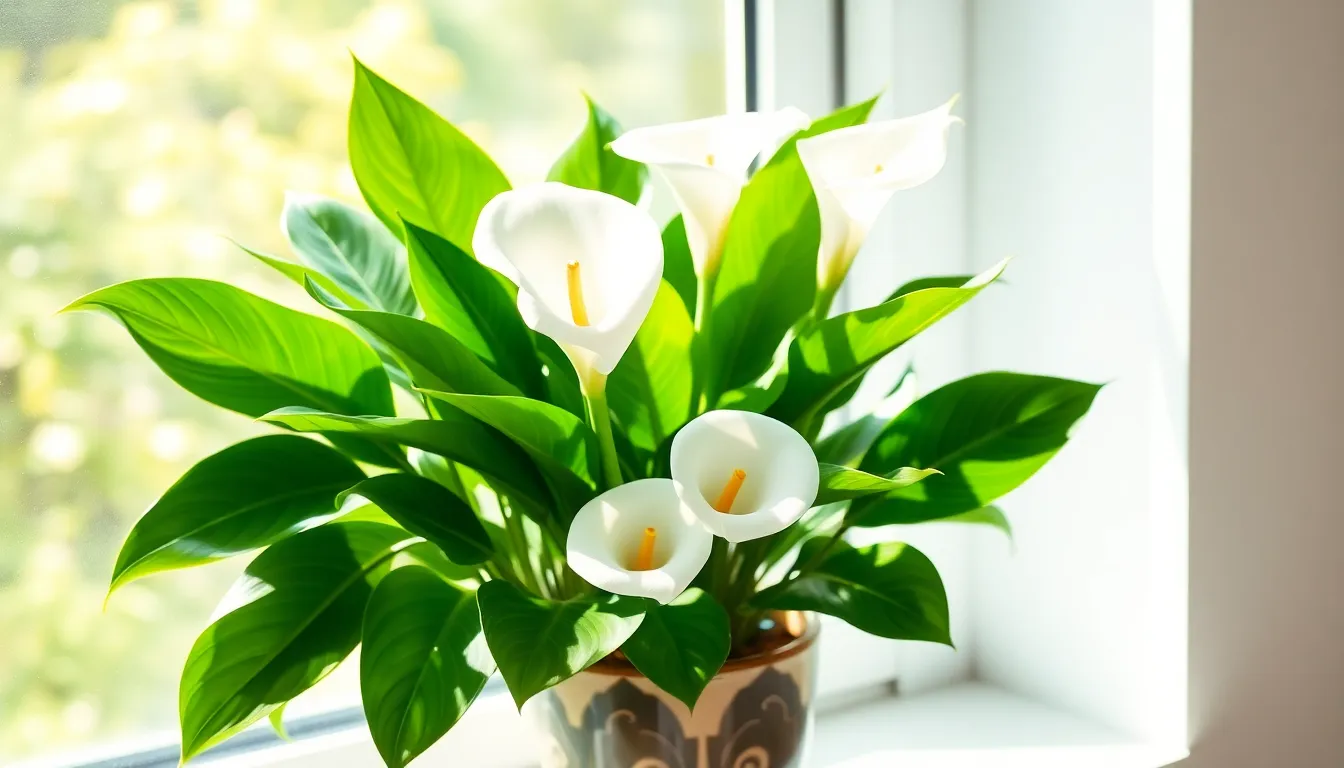Calla lilies are the divas of the plant world, strutting their stunning blooms like they own the runway. With their elegant trumpet-shaped flowers and lush green leaves, they can transform any garden or indoor space into a tropical paradise. But don’t let their beauty fool you; these beauties do require a bit of TLC to thrive.
calla lily plant care
Calla lilies are admired for their elegance and unique beauty. These plants require specific care to thrive and flourish.
Overview of Calla Lily Varieties
Numerous varieties of calla lilies exist, each exhibiting distinct characteristics. Zantedeschia aethiopica, known as the white calla lily, showcases classic trumpet-shaped flowers and green foliage. Zantedeschia rehmannii features vibrant pink or red blooms, adding warmth to any arrangement. Yellow calla lilies, belonging to Zantedeschia ‘Gold Token’, exhibit cheerful hues ideal for brightening spaces. Black calla lilies, derived from Zantedeschia ‘Black Star’, offer dark, dramatic coloration. Diverse varieties contribute to numerous options for gardeners and decorators.
Native Habitat and Growth Conditions
Calla lilies thrive in wetland habitats, primarily found in riverbanks and marshes. They flourish in USDA hardiness zones 8 through 10, demonstrating adaptability to warm climates. Well-draining soil enriched with organic matter is essential for healthy growth. Moderate sunlight exposure, ideally in partial shade or filtered light, further enhances flowering. Maintaining consistent moisture levels supports optimal development and prevents plant stress. Proper attention to these conditions ensures vibrant and healthy calla lily plants.
Essential Care Tips for Calla Lilies



Calla lilies thrive with specific care, ensuring their elegance remains vibrant. Attention to potting, watering, and light conditions plays a significant role in their health.
Potting and Soil Requirements
Choosing a well-draining potting mix is essential for calla lilies. They prefer potting soil enriched with organic matter to retain moisture while preventing root rot. A mixture of potting soil, compost, and perlite offers an ideal environment. Using pots with drainage holes allows excess water to escape. For optimal growth, repot calla lilies every 2 to 3 years to refresh the soil and provide ample space for their roots.
Watering Guidelines
Maintaining consistent moisture is crucial for calla lilies. Water the plants when the top inch of soil feels dry to the touch. Overwatering can lead to root rot, while underwatering can cause wilting. During the growing season, usually from spring to summer, weekly watering is often sufficient. In fall and winter, reduce watering as calla lilies enter dormancy, requiring less moisture.
Light Requirements
Calla lilies flourish in bright, indirect light. Positioning them near a window with filtered sunlight supports healthy growth. Too much direct sunlight can scorch their leaves, whereas insufficient light can hinder flowering. Aim for 6 to 8 hours of indirect light daily for optimal blooming. Rotate the plants occasionally for even light exposure on all sides.
Fertilizing and Pruning Calla Lilies
Fertilizing and pruning calla lilies significantly contribute to their growth and vibrancy. Proper care ensures these plants thrive in any environment.
Best Fertilizers for Calla Lilies
Balanced, water-soluble fertilizers work best for calla lilies. A ratio of 20-20-20 offers a complete range of nutrients. These fertilizers promote flowering and overall health. Applying fertilizer every 4 to 6 weeks during the growing season supports robust growth. Organic options, like compost or well-rotted manure, enrich the soil and enhance water retention. Liquid fertilizers can provide a quick nutrient boost. Diluting them according to the manufacturer’s instructions prevents over-fertilization. After applying, ensure plants receive sufficient water to distribute nutrients effectively.
Pruning Techniques for Healthy Growth
Pruning enhances the beauty and vitality of calla lilies. Removing yellow or dead leaves encourages new growth. Pruning stems after flowering allows for rejuvenation and prepares the plants for the next season. Using sharp, clean scissors ensures a neat cut and reduces the risk of infection. Trimming back foliage in late fall allows for proper dormancy. For container-grown calla lilies, when they outgrow pots, repotting promotes healthy roots. Regular monitoring for pests empowers timely action and prevents infestations. These simple techniques lead to thriving, beautiful plants.
Common Pests and Diseases
Calla lilies may encounter various pests and diseases that can affect their health. Identifying these issues promptly ensures effective management and keeps plants thriving.
Identifying Common Pests
Aphids frequently infest calla lilies, resulting in distorted growth and sticky residue. Spider mites can also pose a threat, often leading to yellowing leaves and webbing on the plant. Additionally, mealybugs may appear as white cottony clusters, weakening the plant over time. Scale insects often form hard, flat bumps on stems and leaves, draining nutrients. Regular inspections for these pests help maintain the plants’ vitality.
Treatment and Prevention Strategies
To combat pests, insecticidal soap effectively eliminates them without harming the plant. Regular exposure to beneficial insects, such as ladybugs, aids in natural pest control. Additionally, maintaining proper watering practices decreases pest attraction. Using neem oil serves as a preventive measure, deterring infestations. Implementing these strategies keeps calla lilies healthy and reduces the likelihood of severe pest problems.

